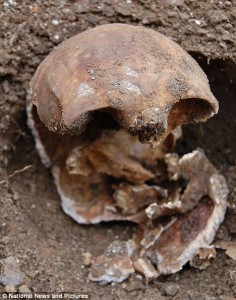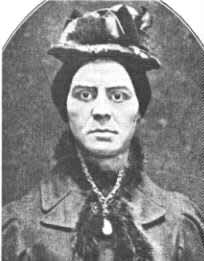 Sir David Attenborough, famed BBC nature documentarian and narrator, found a skull in his garden last October. Workers building an addition to his house in Richmond, south west London, were digging in his back garden, formerly the site of the Hole in the Wall pub, when they uncovered the skull. Attenborough called the police and they confirmed after forensic testing that it had belonged to a woman of menopausal age with missing teeth. It was found on Victorian-era tiles, and radiocarbon dating placed it between 1650 and 1880.
Sir David Attenborough, famed BBC nature documentarian and narrator, found a skull in his garden last October. Workers building an addition to his house in Richmond, south west London, were digging in his back garden, formerly the site of the Hole in the Wall pub, when they uncovered the skull. Attenborough called the police and they confirmed after forensic testing that it had belonged to a woman of menopausal age with missing teeth. It was found on Victorian-era tiles, and radiocarbon dating placed it between 1650 and 1880.
There was immediate speculation that this was the long-missing head of Julia Thomas, a wealthy 55-year-old widow who had lived almost exactly where Sir David’s house is now and was murdered by her housekeeper, Kate Webster, in March of 1879. The case caused a sensation at the time because of the grisly method Webster employed to dispose of the body. She sawed off Thomas’ head with a razor and meat saw, cut off her limbs with a carving knife, then cooked the arms, legs and torso in a copper laundry cauldron. Julia Thomas’ internal organs she burned. Two boys later testified that she given some of the products of this macabre cuisine to them as delicious free pig lard. (Yay free pig lard!)
 Once the body parts were par-boiled, Webster stuffed them into a wooden box, but she couldn’t make one foot and the head fit. She buried the foot in a nearby manure pile, put the head into a black bag and went to visit her friends the Porters. She told them she had inherited a bounty and wanted help selling Once there, she went out again carrying the black bag with her. When she returned to her friends’ house she was bagless. She brought their son Robert back home with her to help her with some stuff, some stuff being the dumping of the wooden box full of boiled corpse. Robert and Kate carried the box to Richmond Bridge. She told him someone was meeting her there to pick it up and shooed him off, then he heard a splash and a few minutes later she caught up with him.
Once the body parts were par-boiled, Webster stuffed them into a wooden box, but she couldn’t make one foot and the head fit. She buried the foot in a nearby manure pile, put the head into a black bag and went to visit her friends the Porters. She told them she had inherited a bounty and wanted help selling Once there, she went out again carrying the black bag with her. When she returned to her friends’ house she was bagless. She brought their son Robert back home with her to help her with some stuff, some stuff being the dumping of the wooden box full of boiled corpse. Robert and Kate carried the box to Richmond Bridge. She told him someone was meeting her there to pick it up and shooed him off, then he heard a splash and a few minutes later she caught up with him.
All this time, Webster was a frequent visitor to the Hole in the Wall pub, among other purveyors of strong drink, sometimes wearing Thomas’ clothing. She even called herself Mrs. Thomas when trying to sell her things. The neighbors reported smelling a foul stench coming from the house.
The box was found in the Thames at Barnes Bridge the next day by coal man Henry Wheatley. At first he thought it was butcher’s off-cuts, but when the authorities realized they were human remains, the story made the news as the Barnes Mystery. Julia Thomas hadn’t been reported missing yet but once the story was in the papers, Robert Porter told his father Henry about the box he carried and the splash he heard. Then Webster sold the contents of Thomas’ house to a friend of Henry Porter’s, pub owner John Church, and Mrs. Church found Julia’s diary, purse and a letter from a Mr. Menhennick in one of the dresses.
Church and Porter compared notes and went to call on Mr. Menhennick. Together with Menhennick’s lawyer, the three men went to the police with their evidence that the Barnes Mystery body was Julia Thomas, and her murderer Kate Webster. The police searched the Richmond house and found an axe, razor, charred human bones and the missing handle from the wooden box found in the Thames.
Webster had fled to return to her native Ireland, but was captured and returned to Richmond for trial. She at first blamed it all on John Church, but he had an excellent alibi so charges against him were dropped. She denied her guilt throughout the trial but was convicted. Prior to her execution by hanging on the 29th of July, 1879, Kate Webster confessed to a priest.
“We had an argument which ripened into a quarrel, and in the height of my anger and rage I threw her from the top of the stairs to the ground floor. She had a heavy fall. I felt that she was seriously injured and I became agitated at what had happened, lost all control of myself and to prevent her screaming or getting me into trouble, I caught her by the throat and in the struggle choked her.”
Then dismembered her, boiled her, impersonated her and stole all her stuff.
Acting Detective Inspector David Bolton testified about the circumstances of Julias Thomas’ murder and Kate Webster’s trial at the coroner’s inquest in West London Coroners Court, using period Old Bailey and prison records as well as the results of modern forensic analysis.
ADI Bolton said there was ‘strong circumstantial evidence’ that the skull, which had fracture marks consistent with the fall down the stairs and low collagen levels consistent with it being boiled , belonged to Mrs Thomas.
Coroner Alison Thompson said: Putting all the circumstantial evidence together there is clear, convincing and compelling evidence that this is Julia Martha Thomas. Doing as ‘best she could’ she recorded the cause of death as asphyxia by strangulation and a head injury.
Despite extensive attempts by ADI Bolton, who was commended by the coroner for his work, no family could be traced.
Julia Thomas’ head will at long last now be given a decent burial.